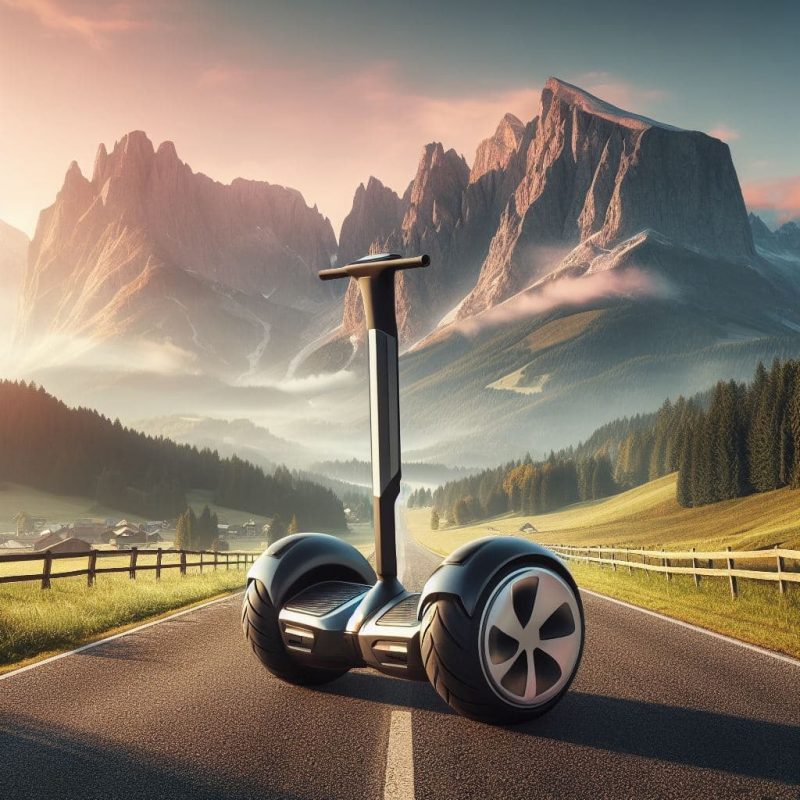Combining the power of electric vehicles with the innovations of self-balancing technology, we are on the verge of a transportation revolution. In this article, we will explore its profound impact on redefining modern transportation.
Unveiling the EV Revolution and Self-Balancing Tech’s Role
The trajectory of electric vehicles is revolutionizing the transportation sector. Governments worldwide have viewed this transition as pivotal, aiming to halt the sales of new petrol and diesel vehicles by 2030 in a bid to achieve a sustainable and green future.
However, it’s not just about transitioning from fossil fuels to electricity. Electric vehicles, especially two-wheelers, are witnessing transformative enhancements in safety, a major one being the integration of self-balancing technology.
Imagine a motorcycle that auto-corrects its balance, mitigating risks and offering a seamless ride, even during halts or slow speeds. This technology not only addresses energy efficiency but also rider safety, fostering confidence among prospective buyers.
In essence, the electric vehicle revolution isn’t just about creating efficient vehicles but sculpting a safer and more inclusive transportation future. The integration of innovations like self-balancing technology signifies the promise of this era – vehicles that are energy-efficient, safe, and accessible to everyone.
What Is Self-Balancing? Definition and Impact
The word “balance” is simple in its expression, but when applied to two-wheelers like bikes or scooters, it becomes a crucial factor in determining one’s safety and riding experience. In the world of electric vehicles, there’s a burgeoning niche captivating the attention of motorcycle enthusiasts – the realm of self-balancing technology.
At its core, self-balancing refers to the technology that automatically stabilizes a two-wheeled vehicle, eliminating the need for the rider to constantly maintain equilibrium. Instead of imagining this with the addition of rudimentary safety wheels as seen on learners’ bicycles, think of advanced mechanisms working silently to keep the ride upright.
Wondering how a self-balancing bike works? Here’s a quick rundown.
The essence of this technology lies in the subtle adjustments made, particularly in the front fork of the motorcycle which links the handlebars to the front wheels. When the bike slows down to speeds less than four kph, the fork angle shifts, bringing the front wheel slightly forward. This minute change activates the self-balancing system which then consistently makes side adjustments, ensuring the bike doesn’t topple over.
Unlike traditional bikes that lean towards the direction of the front wheels, motorcycles equipped with self-balancing technology lean in the opposite direction, always ensuring a stable stance.
The introduction of self-balancing electric motorcycles and scooters is nothing short of revolutionary. Experienced bikers, as well as new learners, have their fair share of struggles when it comes to maintaining balance, especially during halts at traffic signals or during slow rides. Here, self-balancing technology acts as a savior, providing a safer, more stable riding experience.
Another perspective to appreciate this advancement is by comparing it to the driving assistance systems in cars. Just as those systems add an extra layer of safety and convenience for car drivers, self-balancing two-wheeler technologies promise to make motorcycle journeys safer and more accessible for everyone.
With industry leaders like Honda, BMW, and Harley Davidson championing this technology, there’s no doubt that the automatic balance bike and motorcycle niche will continue to grow. As more models are introduced and technology refines further, we can anticipate a future where balancing on two wheels is no longer a skill barrier, but a given.
Innovation in Action: Sensors, Algorithms, and Elevated Electric Riding
Ever thought about how those self-balancing scooters even work? For those familiar with them, curiosity is natural. For the uninitiated, picture this: a stylish self-balancing two-wheeler, balancing front to back, not like the traditional bike that goes side to side.
Technically, it’s termed a “Self-balancing Scooter”, but most people know it as a “Hoverboard”.
So, looking at a hoverboard, you might wonder, “How self-balancing scooter works?” Unlike a bike where balance is maintained by the rider, this board relies heavily on advanced technology.
These hoverboards aren’t just about staying upright. We’re talking self-balancing technology in real-time. There are instant reactions, predictive functions, and the core aim is safety with every roll.
On the exterior, the board might seem to float effortlessly, but inside, there’s a complex system of sensors and algorithms at work. Unlike bicycles, they focus on front-to-back balance, tuning into where the rider is leaning. As the board senses weight shifts, it owes a lot to the tilt sensor and gyroscope.
Delving deeper, advanced algorithms act as the control hub. They’re constantly processing data, making real-time decisions, and ensuring stability. In collaboration with the sensors, these algorithms anticipate the rider’s next action.
The board’s structure shelters all the advanced components. Every wheel houses an electric motor, directly controlled by the rider. These motors derive power from long-lasting lithium-ion batteries. And the motherboard? That’s the board’s central processor, ensuring seamless coordination.
When someone steps onto a hoverboard, the tech springs into action. The sensors and gyroscopes get busy, monitoring every movement and adjusting the rider’s balance. All this information is swiftly processed and converted into precise motor responses.
But there’s more to the story. Beyond just balance, these boards excel in battery management, user adaptation, algorithm fine-tuning, and more. They’re not a temporary trend. Representing the intersection of machinery and software, they hint at the exciting potential of personal transportation.
These hoverboards are the pinnacle of modern tech. Demonstrating how engineering and top-notch algorithms can reshape the way we think about moving from point A to B. Safe, thrilling commutes on a self-balancing two-wheeler? That future is now.
Self-Balancing and EV Sustainability
In the field of modern transportation, the application of artificial intelligence, machine learning, and automation are making a significant appearance. One of the most exciting developments in this line of progress is the arrival of self-balancing motorcycles and scooters.
As electric bikes have marked their undeniable presence in the vehicular domain, the next vision on the horizon for manufacturers is to develop motorcycles that exhibit a degree of autonomy, minimizing the need for human intervention.
At the forefront of this evolution is the commitment to rider safety. The integration of balance-assist systems in conjunction with sophisticated sensors, microprocessors, and motors intends to make bikes inherently more stable. The resultant effect is anticipated to be a marked reduction in riding mishaps and more secured commuting.
Novice riders, in particular, are set to gain immensely from this innovation. A frequent challenge for beginners is managing balance, especially at traffic stops or while parking. Self-balancing technology addresses this concern, allowing the motorcycle to remain upright without the rider’s physical support. Though the full spectrum of safety benefits remains a topic of exploration, the promise is obvious.
Taking a glimpse at the broader electric landscape, self-balancing scooters have already marked their footprint. Running entirely on batteries, these devices not only offer a cost-effective transportation solution but also promise efficiency in various professional sectors like law enforcement and delivery services.
With removable batteries ensuring sustained performance and the capability to bypass traffic congestion, the commute becomes faster and more efficient. The potential of the self-balancing scooter technology is vast, with their amalgamation of technological prowess and sustainability making them a future-forward choice in transportation.
Environmental Advantages of Self-Balancing EVs
In the current age of heightened environmental consciousness, self-balancing electric vehicles like scooters have emerged as champions of green transportation. Not only are these scooters economically viable, but they stand out for their eco-friendliness.
A salient feature that sets them apart is their quiet operation, producing considerably less noise pollution. More significantly, unlike many conventional vehicles, they don’t emit toxic gases, ensuring our air remains cleaner and fresher. This reduction in air and noise pollution makes them superior, environmentally speaking, when compared with other automotive vehicles.
Their contribution extends beyond clean operation, though. The lightweight design of these scooters also means effortless parking, reducing the space and infrastructure strain in urban areas. In essence, self-balancing EVs are not just technological breakthroughs but also forerunners of a sustainable and healthier urban future.
Key Players Embracing Self-Balancing in EVs
As the electric vehicle (EV) landscape evolves, so does the drive for innovation, transcending beyond just electrification. An important area of focus is enhancing rider safety and experience, particularly in two-wheelers. One groundbreaking advancement is the integration of self-balancing technology. Let’s see how industry leaders are pioneering this transformative tech.
Harley-Davidson
Harley-Davidson, an emblematic name in the motorcycle domain, is making waves with its recent patent application for self-balancing technology. This move highlights the brand’s adaptability and forward-thinking approach, especially at a time when they have experienced a dip in sales and a somewhat cautious reception from new riders.
Central to this innovation is a gyroscope housed in Harley’s Tour-Pak top case. This gyroscope, equipped with a heavy flywheel connected to an electric motor, spins between 10,000 and 20,000 rpm. Uniquely designed to move in harmony with the bike’s dynamics, it ensures stability, particularly at slow speeds or standstill positions.
A computer-regulated linear actuator cleverly tilts the spinning mass, counteracting the bike’s lean and keeping it upright. This functionality disengages once the motorcycle exceeds 3mph (around 4.8kph).
For rookies or those not accustomed to Harley’s hefty 300kg+ machines, this technology is a potential game-changer. Moreover, with an aging core customer base, this feature is a thoughtful nod to older riders, enhancing their safety and boosting their confidence.
What sets this development apart is its detachable nature. Integrated within the top case, riders can opt to remove the gyroscope when they feel more assured – a feature reminiscent of bicycle training wheels. This modular design also hints at its adaptability across various Harley models.
Fundamentally, while it’s still in the patent phase, Harley-Davidson’s dive into self-balancing technology reflects its commitment to rider safety and experience, reinforcing its position as an industry frontrunner.
Honda
While many manufacturers step into the self-balancing technology with the tried-and-true gyroscope approach, Honda charts a different path with its innovative Riding Assist technology. Opting to reinvent rather than refine, Honda’s technology is a recognition of engineering finesse, emphasizing function and rider experience.
At the heart of Honda’s Riding Assist is the absence of a gyroscope. Instead, the system hinges on a variable rake angle of the front wheel, combined with a motorized handlebar.
Smartly conceptualized, as speed increases, so does the wheelbase, establishing a positive rake angle for stability. But when the motorcycle cruises at laid-back velocities or confronts sharp bends, the rake dives into the negative territory, pulling back the wheelbase. This allows for quick responses and heightened control, maintaining the bike’s balance in tougher conditions.
The steer-by-wire system, a highlight of the Riding Assist concept, collaborates seamlessly with the motor, managing the wheel’s alternating shifts. This movement, central to the bike’s self-stabilizing feature, provides the motorcycle with stability, particularly when stationary or moving at very slow speeds.
What stands out is the elegance of the concept. Honda’s Riding Assist isn’t about inundating the motorcycle with tech but about harmoniously integrating innovative features to enhance the rider experience. It’s about ensuring that balance, a critical aspect of two-wheelers, is maintained not by overwhelming technology, but by a well-thought-out and engineered approach.
Yamaha Motoroid
In the unfolding domain of self-balancing EVs, Yamaha introduces a cutting-edge contender: the Motoroid. Motoroid stands apart, not just in its self-balancing technology, but in the profound connection it establishes with its rider.
Taking human-like traits to a new level, Yamaha’s Motoroid does more than just balance on two wheels. It recognizes, responds, and resonates with its rider.
Imagine a world where your motorcycle doesn’t just respond to a key or a button, but to the very sight of you.
The Motoroid, affectionately conceptualized by Yamaha, is akin to a loyal companion. Through a state-of-the-art image recognition AI system, it can discern a rider’s face from a crowd and move towards them, reminiscent of a pet happily reuniting with its owner.
The relationship doesn’t end there. The bike also responds to gestures, moving forward with just a simple signal from the rider. This is made possible by the seamless integration of the AI system with Yamaha’s “Active Mass Center Control System,” ensuring the Motoroid remains balanced and responsive.
Beyond its technological prowess, the Motoroid exudes a robotic aesthetic, a deliberate choice by Yamaha. Rather than design first and incorporate technology later, Yamaha took a holistic approach.
Every technological component was developed and perfected before the design phase began, ensuring the exterior encapsulated and complemented the internal innovations. This thorough process results in a bike that doesn’t merely look futuristic; it embodies the future.
At its core, the Yamaha Motoroid is more than just another addition to the self-balancing EV lineage. It’s a demonstration of Yamaha’s visionary approach, weaving together technology and design in a way that not only emphasizes functionality but also fosters a deep, intuitive bond between machine and rider.
In the vast landscape of EV innovations, the Motoroid stands tall, setting Yamaha apart as an innovator in pairing self-balancing technology with human touch.
BMW
In the world of self-balancing technology, BMW has taken a distinct approach with its autonomous R 1200 GS.
Unlike other contenders in the space that emphasize slower, steadier autonomous movement, the R 1200 GS showcases a dynamic capability. It doesn’t just trundle ahead at a consistent pace; it can actually ride off, pick up speed, navigate around a test track, and decelerate to a halt entirely autonomously.
This remarkable achievement is the creation of engineer Stefan Hans and his dedicated team.
Unlike the other motorcycles detailed previously, the R 1200 GS’s self-balancing function isn’t merely about consistent motion. The bike needs momentum to propel itself, and it can come to a stop independently.
This design choice isn’t indicative of BMW’s vision for a completely self-riding future, but rather a strategic move. The primary objective behind the inception of this motorcycle wasn’t to create a fully autonomous vehicle but to assess the performance of various systems. By examining these systems in action, BMW aims to extract valuable insights that can enhance the safety features of future vehicles.
A closer look at the construction of the R 1200 GS reveals precise planning and innovative techniques. The bike’s framework is sculpted using a cutting-edge 3D printing process.
When it comes to the bike’s autonomous prowess, BMW leveraged expertise and technologies from its automotive division, harnessing the potential of synergies between the two.
Crucial elements of the motorcycle, such as the wheels, swing arms and frames, are crafted from lightweight materials, ensuring agility and responsiveness. Yet, to ensure robustness and durability, high-strength carbon was the material of choice, reinforcing the bike’s structure.
This blend of lightness and strength underpins BMW’s commitment to blending performance with safety in its venture into self-balancing technology.
Conclusion
The field of EVs is rapidly evolving, with self-balancing technology at the helm, leading us towards a more inclusive and secure transportation future.




